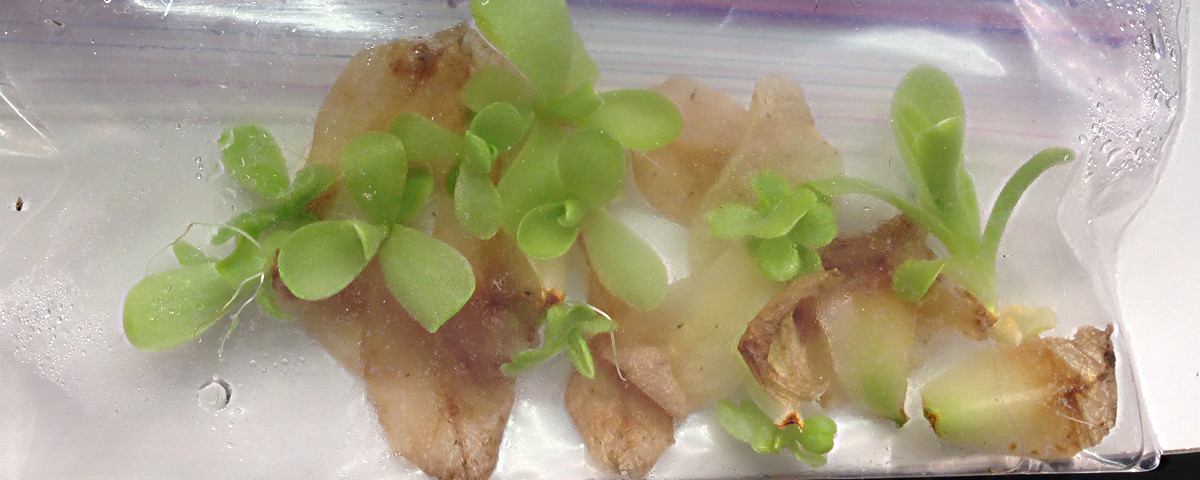
Pinguicula gigantea leaf pullings four months after being placed in a ziploc bag.
The easiest way to propagate Mexican Pinguicula is by leaf pullings. With at least 40 perennial species of Mexican Pinguicula, there is no best way to propagate all the species. However there are general principles that work with most species with minor modifications.
Most Mexican Pinguicula species have two leaf forms. The summer leaves are carnivorous and sticky. Some species may have rather thin summer leaves while other species have succulent summer leaves. The winter leaves are succulent, dry and non-carnivorous. The other species have carnivorous leaves year round but the winter leaves may be smaller. Generally using the winter leaves late in the season works best for all species. However you can be successful with leaves taken at any time. How well a particular set of leaves will work depends on how thick or succulent the leaves are and the propagation technique you use. Please see Fleischmann 2021, On the infrageneric classification of Pinguicula (PDF), for more information on species and leaf types.
Pinguicula tend not to not have much in the way of roots and stems so collecting leaves for propagation can be tricky at times. For pings like Pinguicula ehlersiae that have succulent leaves in winter, the best way to get leaf pullings is to carefully tease the leaves with your fingers and they will either fall off or come off very easily. If you are too rough the whole plant can fall apart. For dormant Pinguicula moranensis-type pings it is best to pull up the whole plant and peel off the outer leaves. You can take up to half the leaves without hurting the plant. This is also the best time of year to repot or refresh the potting medium for your plants. For Pinguicula gigantea and other species that don't go dormant, the leaves may pull off easily after wiggling back and forth any time. Again, be careful not to destroy the whole plant removing leaves unless that is what you want to do. During the summer, Pinguicula gigantea plants can fall apart if repotted for leaf harvesting, while Pinguicula ehlersiae plants can fall apart during the winter if repotted.
There are two common ways to start Mexican Pinguicula leaf pullings. I suspect that any method of keeping the leaves from being too wet or too dry will work. The most traditional way is to lay the leaf pullings on a damp 1:2 mix of vermiculite and perlite. They may or may not need to be covered depending on the humidity and if you occasionally mist them. A derivative of this method is to put whatever your standard Pinguicula potting mix is into small, clear plastic containers with lids and just lay the leaves on top of the soil. The soil should start out damp. Evaporation will fog up the inside of the container and dry out the soil. Put a little water on the soil if the leaves tell you they are too dry and shrivel. This achieves 100% humidity but the leaves are not wet. After plantlets sprout, you can plant them in the soil and increase the soil moisture.
Another way to start new ping plants is to just put leaves in a plastic ziploc bag. This works best for large fleshy leaves. To use the ziploc bag method, just put the clean leaves in a ziploc bag. You do have to watch them carefully. If the leaves are fairly dry, the bag can be zipped shut. If they are wet, the bag opening should be propped open with a clip. You can also put in a piece of blue paper shop towel to help absorb excess water and stabilize the moisture level. (I have found blue paper shop towels to have fewer problems with mold than standard white paper kitchen towels.) If you see a leaf start to rot, open the bag more. If the leaves shrivel, spray in some water and close the bag. Or, if your growing environment is humid enough, just put the leaves in a dish without water. If they start to shrivel, put them in a bag or terrarium or lightly spay them with water.
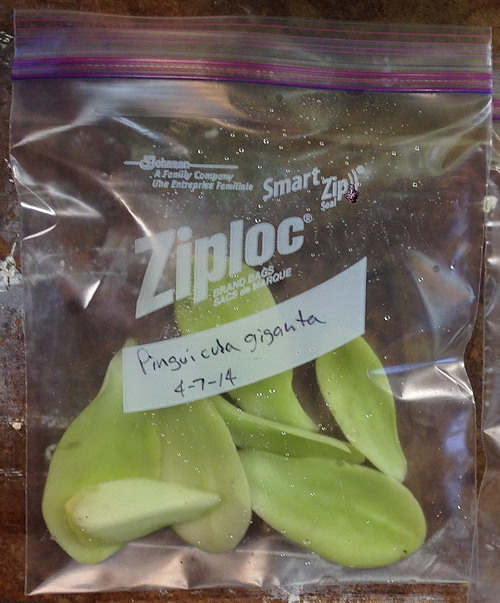
Fresh Pinguicula gigantea leaf pullings in a ziploc bag. With this much leaf mass in a bag, the bag should not be zipped closed completely. You can also remove a large part of the larger leaves if you start having rot problems.
The best time of year to take Mexican Pinguicula leaf pullings is in the spring just before or as the very first summer carnivorous leaves start emerge. In the temperate northern hemisphere this is late March and early April for greenhouse grown plants and from plants otherwise on a natural light cycle. If the leaves are taken at other times, they may take longer to sprout plantlets or the leaves could be too thin and just rot. The leaves don't need intense light and you do need to keep them out of direct sunlight so they don't cook.
One year I did an experiment on Pinguicula ehlersiae leaves with rooting hormone, B1, and both. Neither alone were helpful and both together was definitely not helpful. The leaves sent out roots quickly but it didn't help the new plantlets. I got more and larger plantlets from the untreated leaves. Some times it is best to let nature takes its own course.
It takes 1 to 2 months to get small plants. They should be planted in your regular ping mix after the mother leaf deteriorates and you see roots. My preferred medium is standard pH balanced potting soil with worm castings as fertilizer plus added perlite. Depending on the potting soil mix you can get, you may need to add 2 or 3 parts perlite each part of potting soil. You can also use equal parts perlite, sand, and peat with some calcium carbonate sand or dolomitic lime. Many people use an all mineral soil mix. I have done that but for me getting the right balance of organic soil mix and perlite and not sitting the pots in water constantly has worked much better. Mexican Pinguicula are not bog plants.
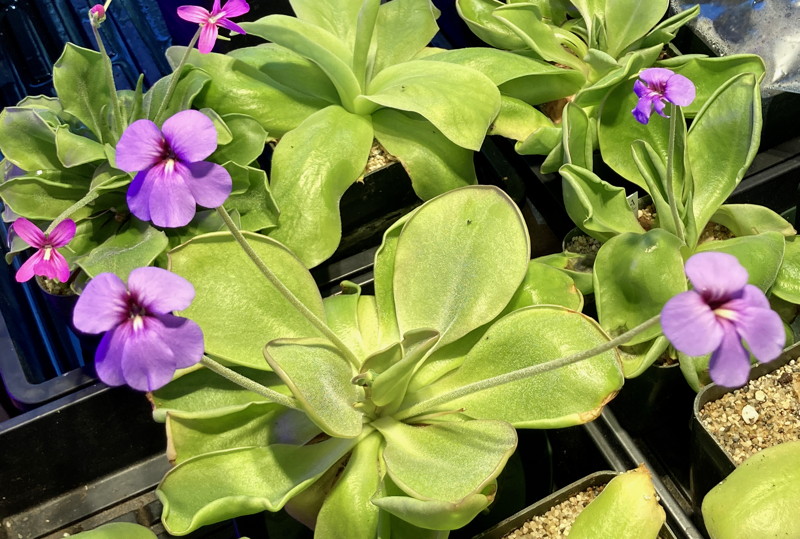
Pinguicula can grow almost explosively with light soil fertilization. I prefer that over spraying the leaves with fertilizer water because it is easy to get too much fertilizer in the crown area of the plant and kill it. It is also easy to over fertilize the soil. The plants above were over fertilized with fertilizer water. Notice the burned leaves on the Pinguicula 'Titan' in the middle and all the plants have leathery, almost dry leaves. However the plants became monstrous. The 'Titan' is 20 cm (8 inches) across. I would be much more careful with small plants.
After a little experimenting with your growing conditions, you should be able to produce mature plants in a year to 18 months.
-- John Brittnacher
March 2005
Updated February 2022
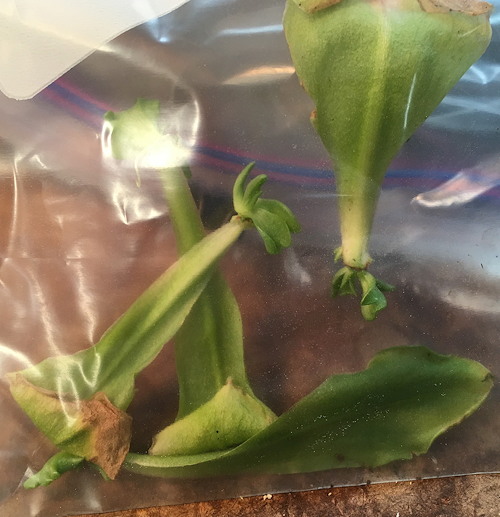
Pinguicula moranensis carnivorous leaf pullings two months after being taken during the summer and placed in a ziploc bag.
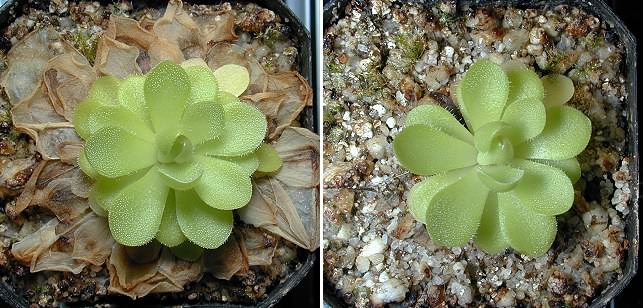
Pinguicula 'Pirouette' before and after non-carnivorous leaf pullings were taken. Note the dried carnivorous leaves in the image on the left.
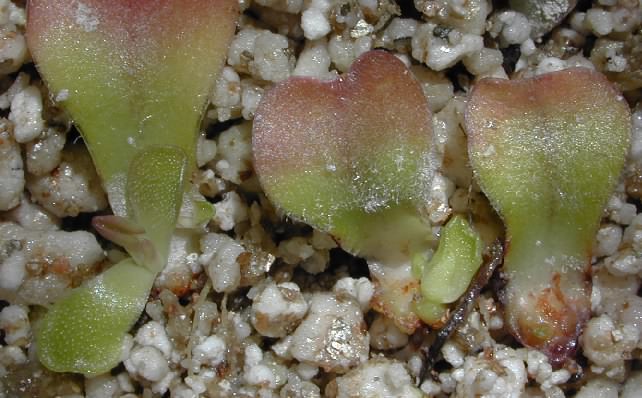
Pinguicula 'Titan' leaf pullings with sprouts. This picture was taken one month after the pullings were taken.
